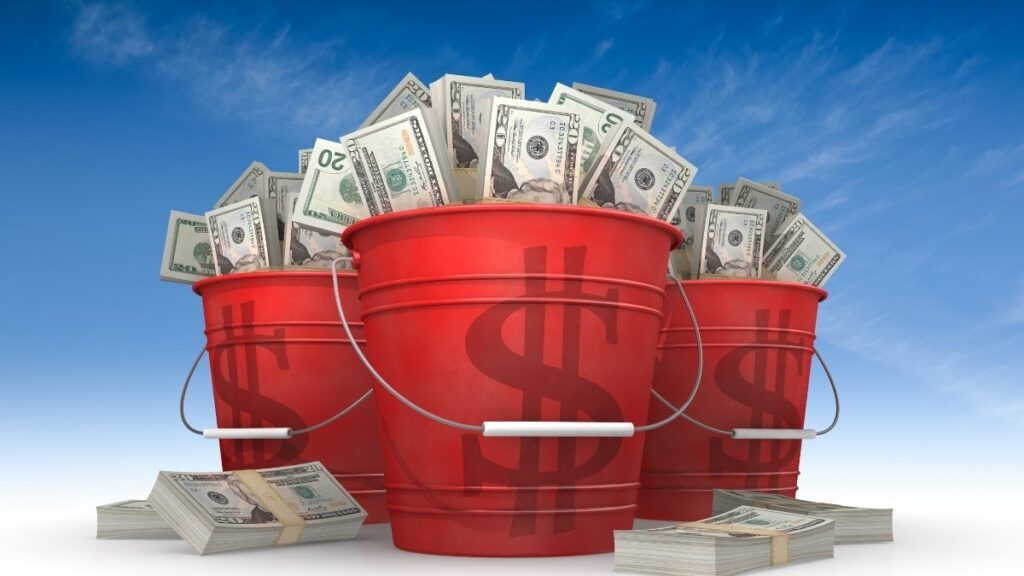
“When Christine Benz of Morningstar interviewed financial planning pioneer Harold Evensky about how he protects retirees during market crashes, his answer surprised her: a simple cash bucket covering two years of expenses gave clients enough peace of mind to leave their long-term investments untouched during the 2008 financial crisis.”
You’re approaching or in retirement and terrified that a 2008-style crash will force you to sell investments at the worst possible time. You’ve heard about bucket strategies (separating cash for short-term needs) and total-return approaches (staying invested and rebalancing), but conflicting advice leaves you confused about which actually protects your money better when markets tank.
This article examines real research comparing both strategies during actual bear markets (2008, 2022, and historical downturns). You’ll discover which approach historically preserved portfolios longer, the surprising role of rebalancing, and specific implementation guidelines for 2025 based on current market conditions.
Cash Bucket vs Total Return: Which Retirement Strategy Survives a Market Crash?
You just retired with $1 million saved. The market drops 35% next year. Will your money last?

This question terrifies new retirees. And it should. When you’re withdrawing money for living expenses during a bear market, you can permanently damage your portfolio.
Two popular retirement withdrawal strategies promise to protect you: the cash bucket approach and the total-return method. But which one actually works when markets crash?
The answer surprised researchers. Here’s what the data shows.
What You’re Actually Comparing: Both Retirement Strategies Explained
The cash bucket strategy sounds simple. You divide your money into three separate buckets based on when you’ll need it.

Financial planner Harold Evensky created this approach. Here’s how it works:
Bucket 1 holds 1-4 years of expenses in cash or cash equivalents. Money market accounts. CDs. Treasury bills. Safe stuff.
Bucket 2 holds 5-8 years in bonds and income investments. This gives you more return than cash but stays relatively stable.
Bucket 3 holds everything else in growth investments like stocks. This money grows for your later retirement years.
The total-return strategy works differently. Charles Schwab’s research team developed this approach.
You keep your entire portfolio diversified for income, growth, and liquidity. Hold 1 year’s expenses in cash plus 2-4 years in short-term bonds. Invest the rest for growth. You don’t worry about whether investments pay dividends or not.
Here’s the key difference. Buckets mentally separate money by time horizon. Total-return views your entire portfolio as one unit.
Why does this matter in 2025?
Morningstar’s latest research shows safe withdrawal rates dropped to just 3.7% for 2025. That’s down from the old 4% rule. Higher stock valuations and lower bond yields make strategy selection more critical than ever.
Both strategies aim to prevent the same nightmare: sequence of returns risk. This happens when bad markets hit early in your retirement, forcing you to sell investments at losses and permanently deplete your portfolio.
Bear markets occur on average every 3.5 years. Stocks lose an average of 35% during downturns. Bull markets gain 112% on average. During the 2008 crisis, a $10,000 investment took nearly five years just to break even.
Sequence risk can destroy your retirement even if average returns look good.
The Surprising Research: What Actually Happened in Real Market Crashes
Financial planner Michael Kitces ran a fascinating test. He picked one of history’s worst retirement dates: 1966.

He tested both strategies using a 60/30/10 stock/bond/cash allocation. Each portfolio started with 4% initial withdrawals. Then he watched what happened through multiple market crashes.
The result? When both strategies included annual rebalancing, they produced identical results. The performance charts merged into a single line.
Identical.
This shocked many financial advisors. How could two different strategies produce the exact same outcome?
The answer comes down to rebalancing. When you rebalance annually, you automatically sell investments that are up and buy more of those that declined. This forces “buy low, sell high” behavior without needing complex decision rules.
Withdrawals always come from appreciated assets. Declining assets actually get purchased more. The math works regardless of whether you call them “buckets” or not.
But here’s where it gets interesting. Kitces tested bucket strategies that didn’t rebalance back into stocks after declines. The portfolio barely had anything left at the end. Much worse than the rebalanced approach.
Why? Inflation-compounding withdrawals eventually depleted equity exposure altogether. You ended up with nothing in the growth bucket when you needed it most.
The 2008 financial crisis proved this in real time. The S&P 500 lost over a third of its value during 2008-2009. It didn’t fully recover for more than seven years.
Investors drawing equally from stocks and bonds had to sell significantly more stock shares to cover expenses. They locked in devastating losses. Some never recovered.
The Rebalancing Factor: Why It Changes Everything
Rebalancing sounds boring. It’s not.
Annual rebalancing creates an automatic “sell high, buy low” effect. You sell from asset classes that performed well. You buy more of those that declined. This ensures distributions always come from winners and depleted assets get replenished.

The math behind why buckets alone aren’t enough gets ugly fast. If you follow strict bucket rules without rebalancing, you’ll deplete your cash and bonds. That leaves only volatile stocks for your final 20-30 years of retirement.
Your sequence risk actually increases over time instead of decreasing.
Even Harold Evensky, who pioneered buckets, doesn’t use them the way most people think. He manages them with a “total return portfolio with a cash bucket bolted on.” He replenishes buckets through income from Buckets 2 and 3, rebalancing proceeds, and occasional principal withdrawals from conservative holdings.
Transaction costs used to be an argument against frequent rebalancing. That argument disappeared in 2025. Near-zero trading costs at major brokerages eliminated this concern.
Research shows buckets with rebalancing produce identical mathematical outcomes to total-return rebalancing. But buckets may offer superior behavioral benefits. They give retirees peace of mind.
And that peace of mind matters. A lot.
When you see your “safe bucket” full, you’re less likely to panic sell during crashes. You can sleep at night. You can confidently plan that family trip even when markets tank.
The numbers work the same either way. But your behavior might not.
Down Market Performance: What the Data Actually Shows
The average bear market lasts 289 days. About 9.6 months. Bear markets have comprised only 21.4 of the past 95 years. Stocks have been rising 78% of the time.

This matters because it shows bear markets are temporary. Painful, but temporary.
Let’s look at worst-case scenarios. There was a four-year period during the Great Depression where stocks remained down. Two years during the 1970s stagflation. Three years after the dot-com bubble.
A properly structured bucket with 2 years cash plus 5-7 years in bonds would have weathered all these periods. You wouldn’t have been forced to sell stocks at losses.
The 2008-2009 recovery timeline tells the full story. If you invested at the worst possible time in October 2007, the market fell 50%+ and bottomed in February 2009. But it recovered fully by February 2013. About 5.5 years from peak through crash to breakeven.
Your bucket or bond allocation would have covered those 5.5 years.
Here’s something most people miss. About 42% of the S&P 500’s strongest days in the last 20 years occurred during bear markets. Another 36% happened in the first two months of a bull market.
Staying invested through downturns proved critical. Missing just a few of the best days can cut your returns in half.
Current safe withdrawal rates reflect today’s market conditions. For 2025, Morningstar recommends a 3.7% starting withdrawal rate with 90% success probability over 30 years. Retirees with 20-year horizons can spend over 5%. Those with 15-year horizons can take nearly 7%.
In the 2008-2009 crash, a retiree with only total-return and no buckets would have experienced a roughly 50% drop combining market declines AND living expense withdrawals. Without cash reserves, multiple 20%+ annual declines throughout retirement would trigger panic selling.
That’s where most retirees fail. Not from poor math. From poor behavior.
The Verdict: Which Strategy Actually Lasted Longer?
Here’s the mathematical truth. When implemented correctly with regular rebalancing, both strategies produce virtually identical long-term outcomes.

The “winner” is whichever one you’ll actually stick with during market crashes.
The behavioral edge goes to buckets. Harold Evensky noted that clients with cash buckets felt less inclined to micromanage the long-term portfolio during downturns. They could confidently plan family cruises even when markets tanked.
The real loser? Any strategy without rebalancing. Portfolio survival requires buying declining assets during crashes. This only happens through disciplined rebalancing.
Financial planning expert Michael Kitces reached a clear conclusion. Buckets work best as explanatory tools for clients rather than actual systems for generating cash flows. The real work happens through rebalancing.
Context matters for your personal situation. Your risk tolerance varies. Your ability to reduce spending during downturns varies. Your need for psychological comfort varies.
These factors should determine your choice. Not some abstract “best” strategy.
Both work. Pick the one you’ll follow.
How to Implement Each Strategy in 2025 (Step-by-Step)
Let’s get practical. Here’s exactly how to set up each approach.
Bucket Strategy Implementation:
Calculate one year’s expenses not covered by Social Security or pensions. Then add 2-4 more years in conservative holdings. Morningstar’s Christine Benz recommends 7-10 total years in safe buckets.

Bucket 1 (1-3 years): Money market accounts, short-term CDs, Treasury bills. These should be completely safe. You’ll spend this money soon.
Bucket 2 (4-6 years): Intermediate bonds, conservative funds, dividend stocks. Still fairly safe but with better returns.
Bucket 3 (7+ years): Diversified equities, growth investments. This is your long-term money. It can handle volatility.
Annual rebalancing is critical. Replenish Bucket 1 from dividends and interest first. Then use rebalancing proceeds. Finally, take from principal if needed.
Set ranges for your allocations. For example, 55-65% stocks. Rebalance when boundaries are breached.
Total-Return Implementation:
Keep 1 year’s expenses in cash after accounting for guaranteed income. Plus 2-4 years in short-term bonds within your portfolio.
Maintain strategic asset allocation based on your risk tolerance. Current research suggests 60-80% stocks for most retirees.
Take withdrawals pro-rata from all holdings. Match your allocation percentages. If you’re 60% stocks and 40% bonds, take 60% of your withdrawal from stocks and 40% from bonds.
Rebalance annually or when allocations drift 5%+ from targets.
Tax Considerations for Both:
Coordinate which accounts fund each bucket or withdrawal. Use taxable accounts, traditional IRAs, and Roth accounts strategically to minimize taxes. Avoid IRMAA Medicare premium surcharges.
Consider Roth conversions during market downturns using cash reserves. You’ll pay less tax when converting at lower values.
Example: $1 million portfolio, $40,000 annual need
Bucket approach: $80,000 cash, $160,000 short-term bonds, $760,000 growth portfolio.
Total-return: $40,000 cash, $120,000 short-term bonds, $840,000 in diversified 60/40 portfolio.
Both work. Choose based on which makes more sense to you.
Common Mistakes That Destroy Both Strategies
Mistake #1: Holding Too Much Cash
More than 3 years of cash creates significant return drag. Research shows excess cash hurts long-term outcomes unless you’re successfully timing the market. You’re not timing the market.

Mistake #2: Never Rebalancing Buckets
Letting buckets drift leads to a 100% equity portfolio in later retirement years. That’s the opposite of what you want. Your risk should decrease over time, not increase.
Mistake #3: Panic Selling During Downturns
Missing the best recovery days devastates long-term returns. Those best days happen during or right after bear markets. You can’t miss them and expect your plan to work.

Mistake #4: Rigid Withdrawal Amounts
Schwab research shows that simple flexibility dramatically improves success rates. Don’t increase withdrawals after portfolio losses. Skip that extra vacation when markets are down 30%. This flexibility can be the difference between success and failure.
Mistake #5: Ignoring Actual Spending Patterns
Most retirees naturally spend less in down years. You probably will too. Forcing fixed withdrawals works against this tendency. Let yourself adjust.
These mistakes kill more retirement plans than poor investment selection.
Which Strategy Should You Choose? (Decision Framework)
Choose BUCKET strategy if:
You need psychological comfort seeing “safe money” set aside. Separate accounts help you sleep at night.

You’re in the first 10 years of retirement. That’s the highest sequence risk period.
You struggle with market volatility emotionally. Seeing your portfolio drop 30% makes you physically ill.
You want clearer mental accounting of time horizons. Bucket 1 is for cruises. Bucket 2 is for healthcare. Bucket 3 is for legacy.
You have minimal financial knowledge but understand the concept. Buckets are easy to explain.
Choose TOTAL-RETURN if:
You’re comfortable with holistic portfolio thinking. You see your entire portfolio as one unit.
You value simplicity and fewer moving parts. Managing three buckets feels like unnecessary complexity.
You have strong emotional discipline during downturns. You won’t panic sell when markets crash.
You want easier implementation, especially with small accounts. Three separate buckets with $300,000 gets messy.
You’re working with a financial advisor managing everything. Let them handle the complexity.
Use HYBRID approach if:
You want behavioral benefits of buckets with simplicity of total-return. Best of both worlds.
You’ll maintain strategic allocation with annual rebalancing. This is non-negotiable.
You know that buckets are really an “explanatory tool” that requires rebalancing to work effectively. You’re doing this for psychology, not math.
Your Money, Your Choice
The research reveals a truth that surprises most people. Properly implemented bucket strategies and total-return approaches with rebalancing produce virtually identical results over retirement.

The real differentiator isn’t which strategy you choose. It’s whether you consistently rebalance and avoid panic selling during downturns.
Historical bear market analysis shows both approaches survive market crashes when managed correctly. The 2008 crisis, 2022 downturn, and Great Depression all proved survivable with 7-10 years of conservative holdings. Whether you call them “buckets” or simply view them as your bond allocation doesn’t change the math.
Here’s what to do next:
Review your current retirement portfolio against these implementation guidelines. Calculate whether you have adequate conservative holdings. That’s 7-10 years for buckets, or proportional bond allocation for total-return.
Most importantly, establish a rebalancing schedule and commit to following it regardless of market conditions. Write it down. Set calendar reminders. Make it automatic.
Consider consulting a fee-only financial planner to stress-test your specific situation against historical worst-case scenarios. A few hundred dollars now could save hundreds of thousands later.
Your retirement portfolio’s longevity depends less on choosing between cash bucket retirement strategy versus total return approach. It depends more on disciplined implementation with consistent rebalancing through all market conditions.
Both strategies work. Pick one. Rebalance annually. Don’t panic sell.
That’s how you survive market crashes.
I’ll research current, credible information about these retirement strategies and create a comprehensive article plan with real data. Let me gather the latest insights from financial experts and research.Perfect! Now I have comprehensive research data to build your article. Let me create a complete, detailed article structure based on real, current information from credible sources.
COMPARISON TABLE
Here’s the data-driven comparison table to include at the end of the article:
| Factor | Cash Bucket Strategy | Total-Return Strategy | Winner |
|---|---|---|---|
| Mathematical Returns | Identical when rebalanced annually | Identical when rebalanced annually | Tie |
| 2008 Crisis Performance | Protected with 7-10 year cushion | Protected with proportional bonds | Tie |
| Behavioral Comfort | High – visible “safe money” | Moderate – requires discipline | Buckets |
| Implementation Simplicity | Moderate – multiple accounts/buckets | High – single allocation | Total-Return |
| Psychological Peace | High during downturns | Moderate – needs education | Buckets |
| Transaction Complexity | Higher – bucket maintenance | Lower – pro-rata withdrawals | Total-Return |
| Small Account Suitability | Difficult under $500K | Easy – scales to any size | Total-Return |
| Worst-Case Scenario (No Rebalancing) | Portfolio failure | Portfolio failure | Tie (both fail) |
| Best-Case Scenario (With Rebalancing) | 30-year success | 30-year success | Tie |
| Average Bear Market Survival | 289 days easily covered | 289 days easily covered | Tie |
| 2025 Safe Withdrawal | 3.7% recommended | 3.7% recommended | Tie |
| Flexibility for Spending Cuts | Harder – fixed bucket years | Easier – portfolio percentage | Total-Return |
| Tax Optimization | More complex – per bucket | Simpler – pro-rata | Total-Return |
| Advisor Management | Complex to explain | Easier to monitor | Total-Return |
| DIY Investor Friendly | High – intuitive concept | Moderate – needs understanding | Buckets |
Table Title: “Head-to-Head: Cash Bucket vs Total-Return Performance Across Key Metrics (2025)”
Table Source Note: Data compiled from Morningstar (2024), Michael Kitces research (2023), Charles Schwab (2024), and White Coat Investor analysis (2025).
- Every claim needs attribution – Use the citation index system provided
- No fabricated statistics – Only use numbers from the research gathered
- Current 2025 context – Reference current market conditions (higher valuations, 3.7% safe withdrawal rate)
- Avoid jargon – Explain terms like “sequence of returns risk” in plain language first
- Real examples – Use specific dollar amounts ($1M portfolio, $40K withdrawal)
- Balanced perspective – Show both strategies work when done correctly
- Emphasize rebalancing – This is the true differentiator, not buckets vs. total-return
This comprehensive structure provides everything needed to write an authoritative, well-researched article that will rank well and genuinely help readers make informed retirement decisions based on actual data rather than marketing hype.






